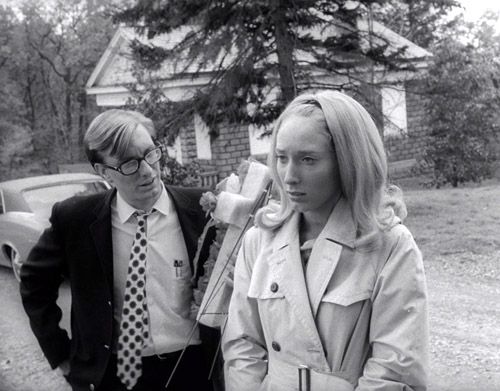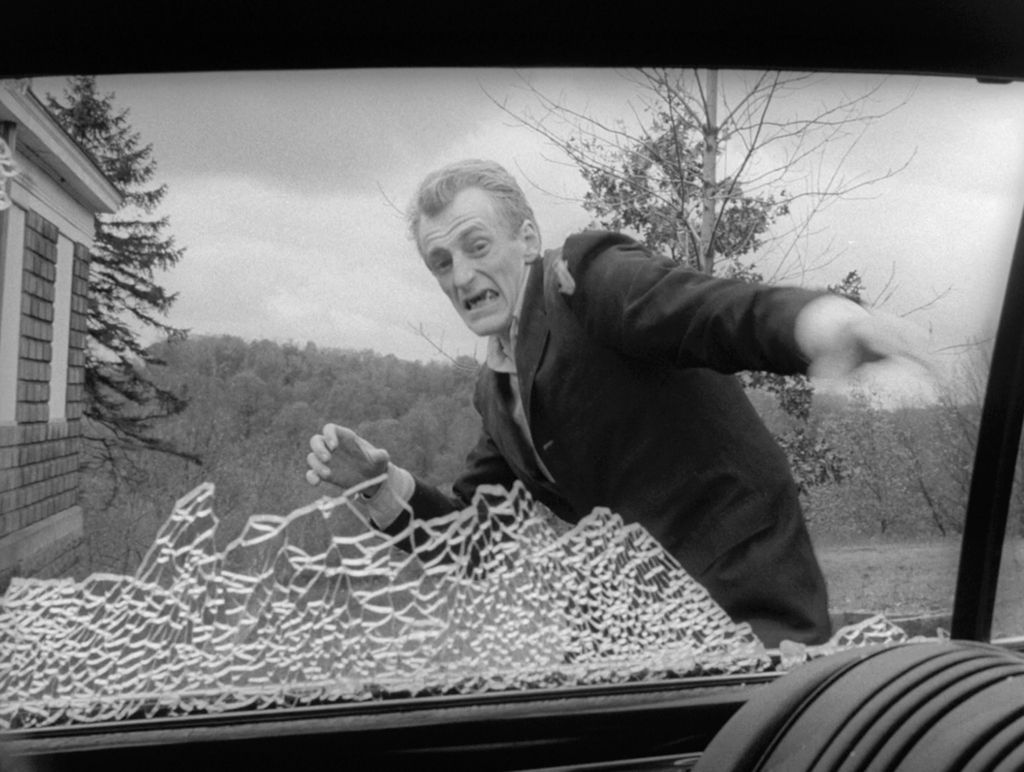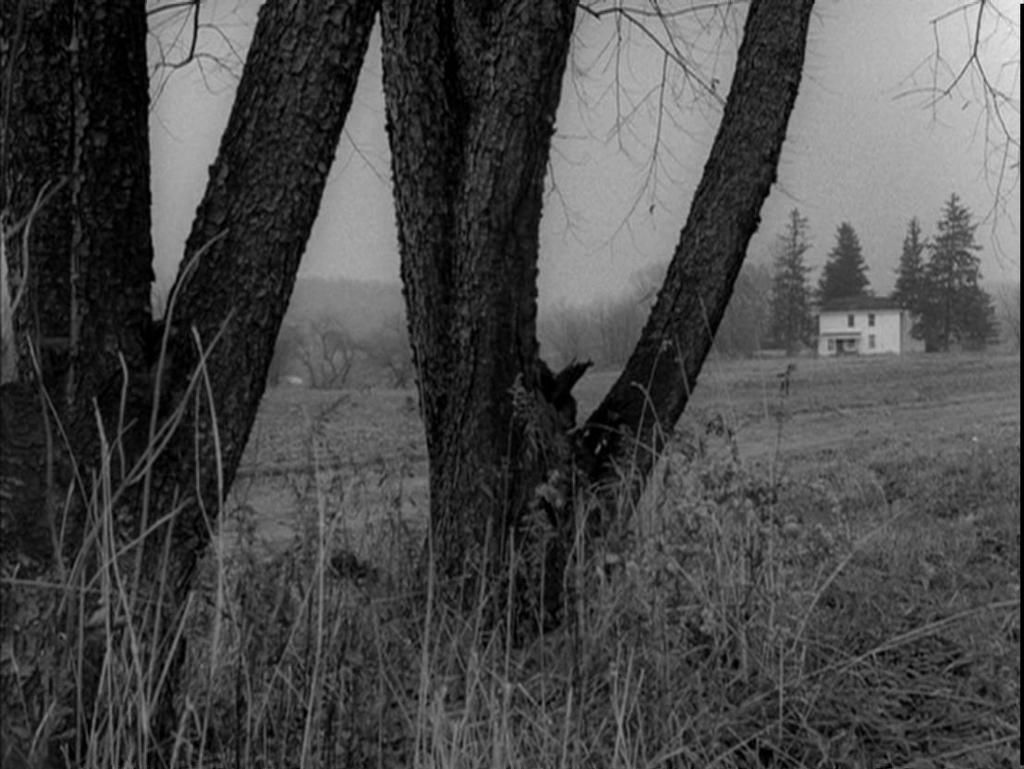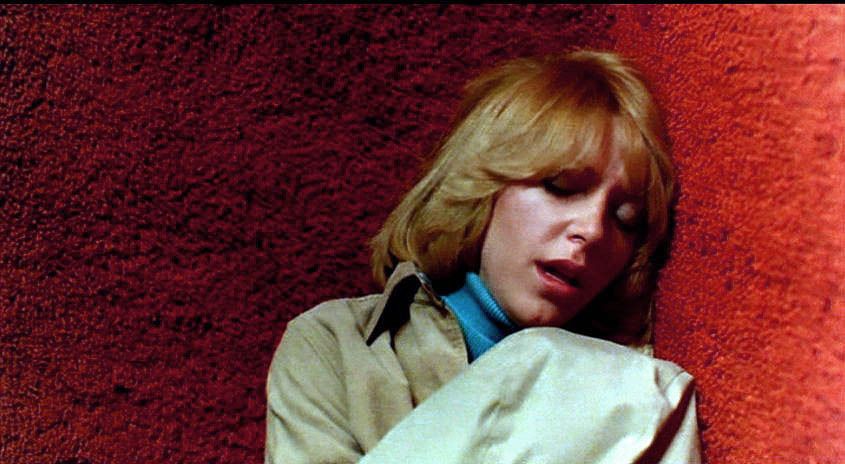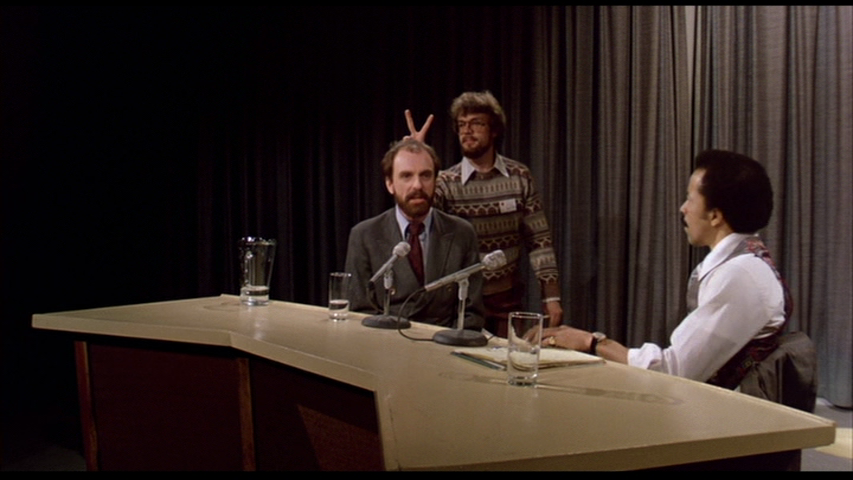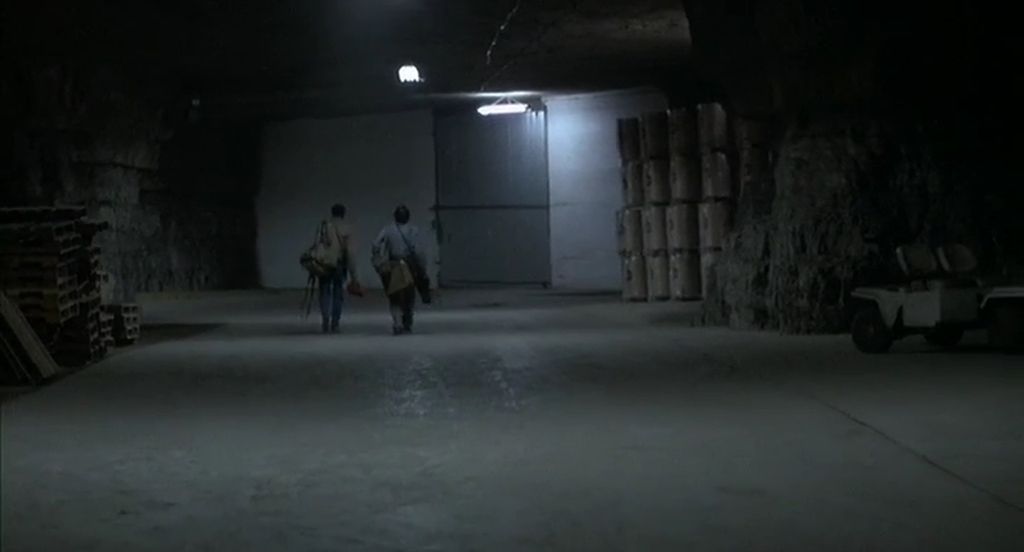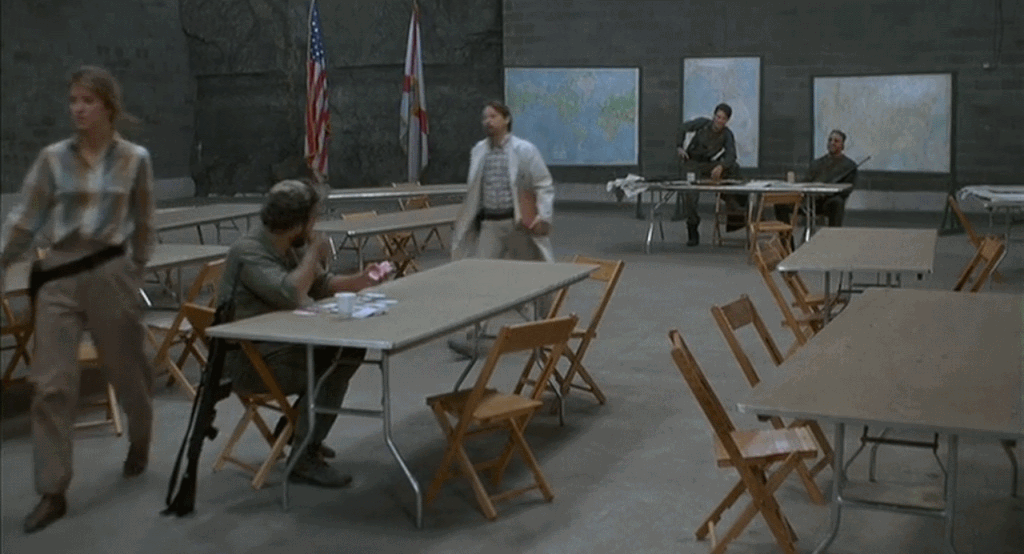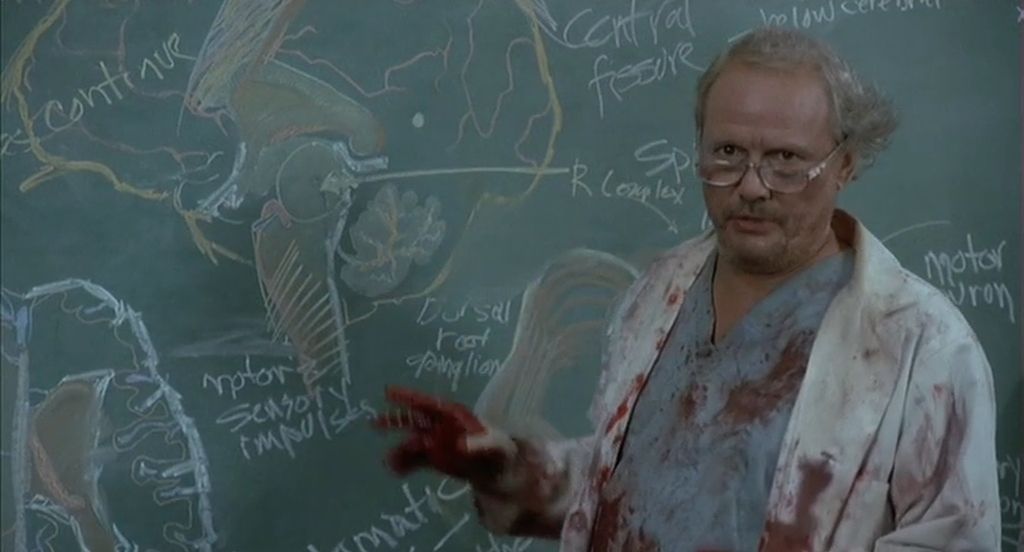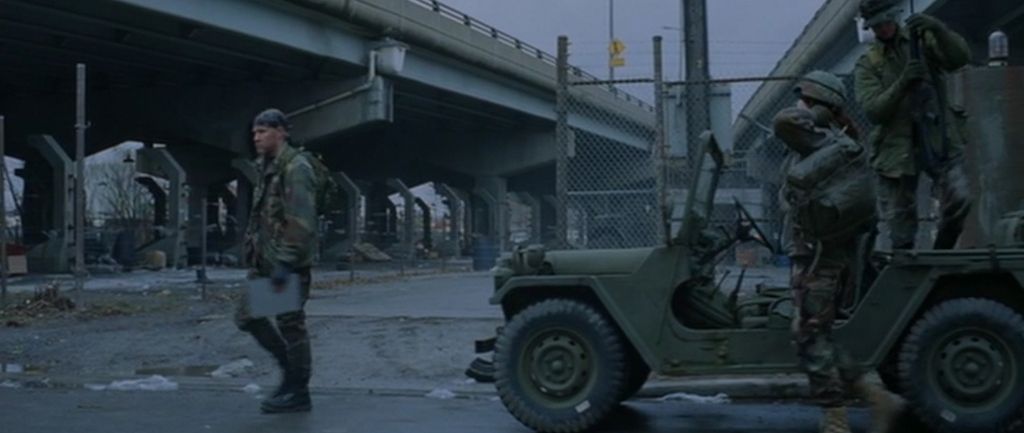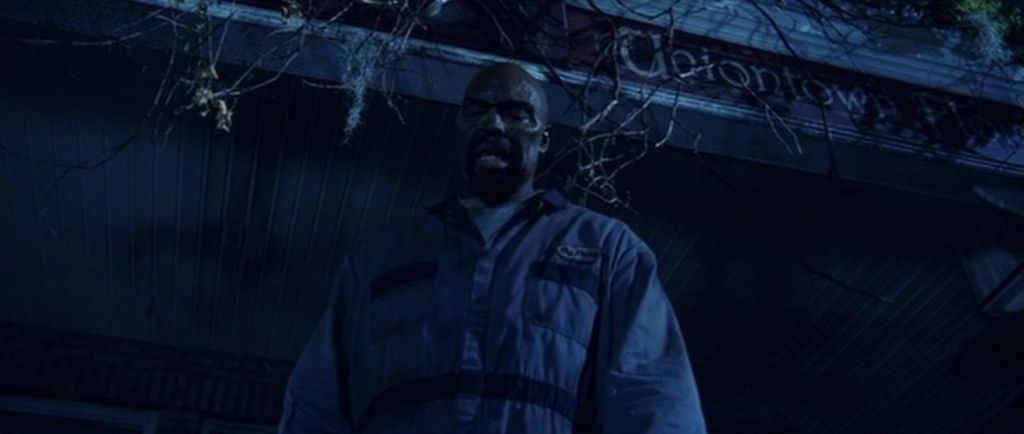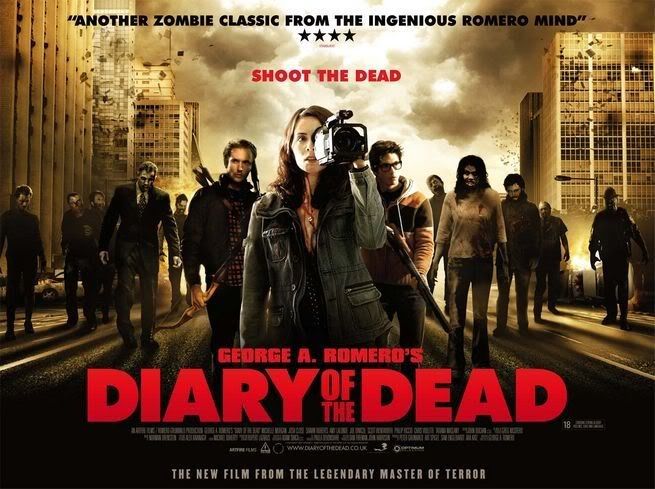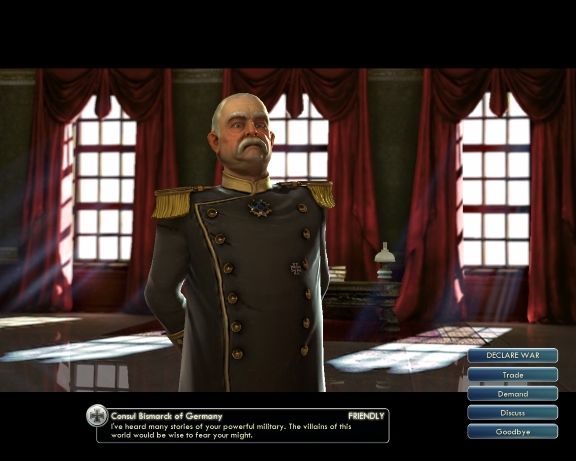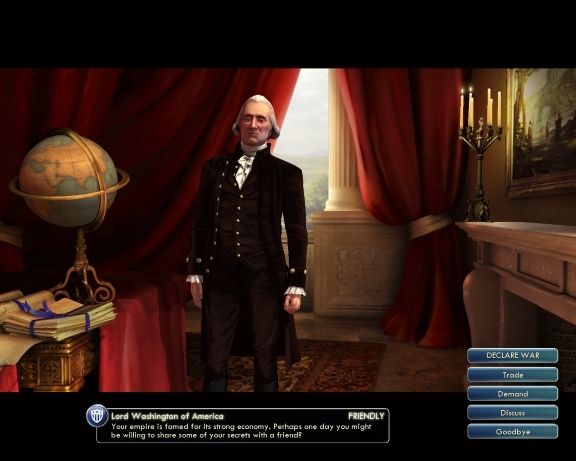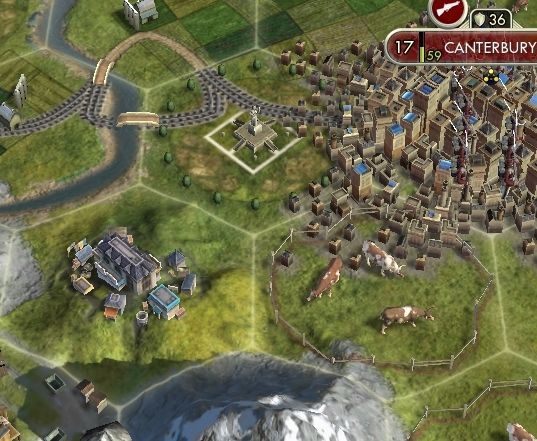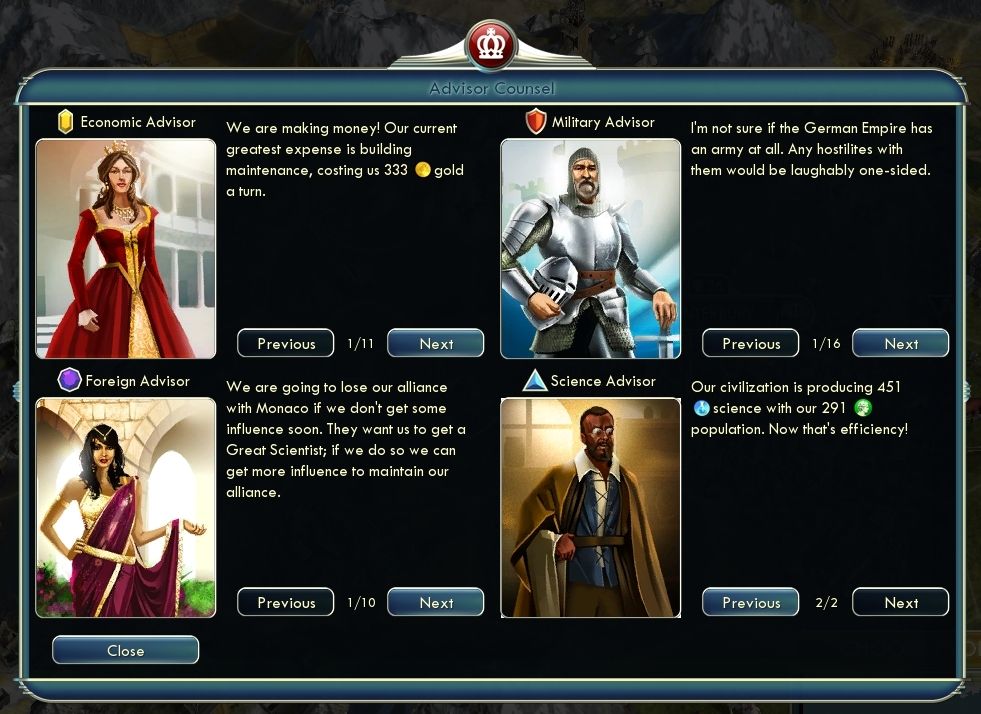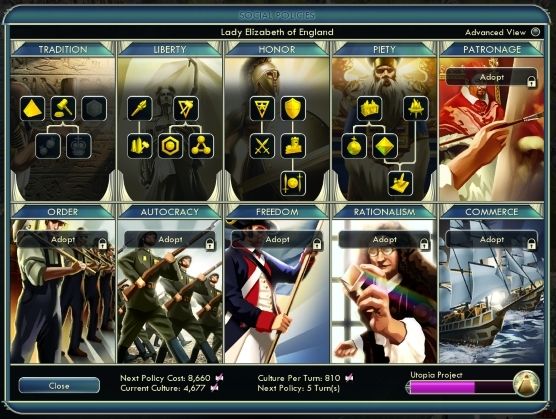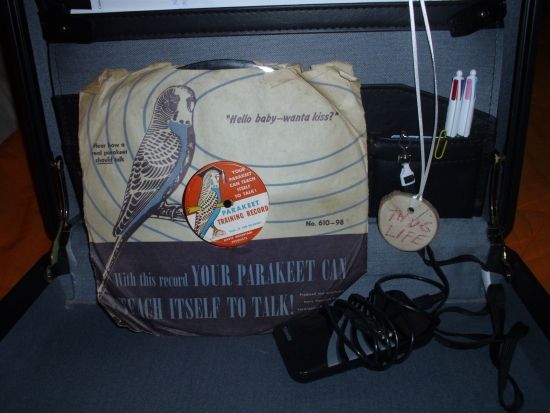Night of the Living Dead (1968)
What's curious about the influence of Night of the Living Dead is that its production values have become just as definitive as its content. The very concept of the living dead was born from budget restrictions, which set the theme for the entire production. This was a movie shot with whatever Romero could get his hands on, and for that reason the whole affair remains grounded in a terrible reality no matter how surreal the proceedings get.
Johnny and Barbara
Night of the Living Dead does more with less than any movie I can think of. The entirety of the film (minus footage shown on TV) takes place inside of perhaps one square mile. We start with a car pulling up to a cemetery, where a brother and sister (who don't much care for each other) leave flowers on a grave of a relative they don't seem particularly interested in. Johnny realizes that being around so many dead people scares Barbara and picks on her before being assaulted by a zombie. Barbara runs.
All of this unfolds in less than ten minutes. We've been introduced to a setting and three characters (not counting a snippet of radio broadcast), and yet we've been given a sense of both what this world is like and that something very unexpected and wrong has just happened. All of this spools out in black and white, a production decision I believe was born of the same budget restrictions that inspired the zombies themselves and would lead to the use of chocolate syrup in lieu of blood later on.
Bill Hinzman, the first Romero zombie
The first zombie in the cemetery, Bill Hinzman, is incredibly iconic, which is why it's so strange that he acts almost nothing like Romero's later zombies. Remember that the people making this film had never seen what we'd consider a zombie movie because those types of movies didn't exist yet. Despite the fact that Romero zombies are considered "slow," since the mode of locomotion most associated with them is a kind of shambling shuffle, Hinzman runs, in a strange, loping gate that suggests both of his legs have gone to sleep.
Babara's escape is remarkable in and of itself for how many cliches it contains. We get the rumble of thunder and the flash of lightning as Hinzman looks up from the fallen form of Johnny, even though it never rains or even continues thundering. We get to see Barbara screw up her escape by slipping out of her shoes and falling down. She gets to the car and then can't start it, because Johnny had the keys, so she lets the parking brake out and rolls down the hill into a tree. Finally, she makes it to a nearby farmhouse just as the sun sets. (And the sun sets hard, going from midday to twilight to night in the space of perhaps a minute. As noted in the Rifftrax - see below - "the sun didn't set, it crashed.")
The farmhouse
The rest of the movie unfolds at the farmhouse, where a strange ensemble arises (a number of people turn out to be hiding in the basement). Barbara meets Ben, who rolls up after nightfall just as her nerves hit the breaking point. Barbara is one of the most helpless women ever depicted on film - she spends the rest of the movie semi-comatose in shock - but Romero almost makes up for it in Ben, who is black.
The part of Ben, who is the closest thing Night gets to a hero, wasn't specifically written for a black man; Duane Jones was just the actor who impressed Romero most with his audition. And it's interesting to watch the movie with that in mind, because it is never actually mentioned that Ben is black, trapped here in a farmhouse full of scared white people in 1968. This is important, because much of the movie's second act is a series of arguments between Ben and an older man named Harry Cooper, and it's never really clear if Cooper dislikes Ben because he's black, because he's young, or simply because Cooper is naturally a dick to people.
Ben (top) and Harry Cooper
Night of the Living Dead thrives on the things it doesn't pin down. The biggest one is why the dead are returning to life. Some speculation, shown in an emergency TV news broadcast the survivors watch, is that it has something to do with a probe to Venus that was destroyed on reentry to Earth because of anomalous radiation. The probe doesn't get mentioned a whole lot, and isn't mentioned at all in any of the sequels, because Romero's guiding thought in creating zombies was actually quite simple. According to him (in an interview in Birth of the Living Dead, see below), zombies were simply a representation of what would happen if things suddenly changed.
Famed as the birthplace of the modern zombie, Night is just as important for what it doesn't establish: the zombie apocalypse. The film's ending is so incredibly bleak that one could be forgiven for forgetting that the humans are actually shown winning at the end. Night of the Living Dead basically invented the zombie genre, but in doing so never really gets the chance to inhabit it. That honor would fall it its sequel.
If you liked Night of the Living Dead, try....
- An excellent primer exists in the form of Birth of the Living Dead, a 2013 documentary on the film's origins and production history. It's a good place to start if you've already seen the movie and want to know more.
- Considering its status in the public domain, it's a shame that Night has never received a proper comedy dub. An effort was made in 1991's Night of the Day of the Dawn of the Son of the Bride of the Return of the Terror, but not much of one. The (very loose) premise is that the zombies are actually disgruntled workers just getting off shift, and the survivors pick somebody to go outside in search of pizza. The humor is too harsh and rambling to really make for an effective theme comedy; a good example is a running joke that goes nowhere about Barbara (dubbed in falsetto by a man) hearing a duck in the distance and being unable to locate it.
- Still, one spectacular joke almost makes it worthwhile. When the sheriff comes up to the burned-out truck in the film's closing minutes, he eyes it considerately and sagely mutters, "I've seen this kind of thing before. It's a truck."
- A somewhat-better stab at comedy comes in the form of the RiffTrax cover, but considering its pedigree (RiffTrax is run by many of the former stars of Mystery Science Theater 3000, as its website's header text helpfully explains) I had hoped for better. This one is basically Mike talking to himself, alone, which is a downer so big I was never completely able to enjoy the jokes. Movie mockery is supposed to be a group activity, dammit.
Dawn of the Dead (1978)
Dawn of the Dead has one of my all-time favorite movie openings, magnificent in its garish simplicity. The camera opens up on a section of carpet that is so orange it is nearly fluorescent. Viewers' eyes get perhaps a second or so to adjust to this, and then there is a loud synth power chord as the movie's title comes up. Welcome to the end of the world. It's 1978.
Frannie, swaddled in the comfort of 1978
Romero has a strange relationship with continuity. It isn't that he doesn't care - there's a great sequence of a zombie getting murdered with a screwdriver in Dawn that only exists to explain why a character is wearing a jacket in some (already filmed) shots and not others - but Romero decided not to pick this fight. Night of the Living Dead looks entirely like 1968, and Romero decidedly to simply accept that a decade had passed between it and this first sequel, trusting that audiences would do the same.
As covered in Birth of the Living Dead, George Romero's career immediately before becoming a filmmaker was in television. He shot segments for Mister Rogers' Neighborhood (of all things) and did commercials. As such, it's kind of appropriate that Dawn opens in a TV station (that hideous red-orange carpet is actually on the walls). The first character we meet is Frannie (Gaylen Ross), who awakens to find that civilization is disintegrating.
It's hard to say whether more of the madness in the studio of WGON is unfolding in front of the cameras or behind them; the impression we get as Frannie walks out into the control room is that regard for order has completely lapsed. Production people are arguing with on-air talent. Curse words, strangely absent in Night, abound. Nobody knows anything and everyone is mad about it.
A WGON emergency broadcast
The only real clue to a timeframe we get comes in this scene; we hear a man yelling about the situation of "the last three weeks." This seems about right, even if Night takes place explicitly in the spring and Dawn implicitly in late fall. The zombie problem is clearly causing people to doubt the structural integrity of civilization, and even as she watches people in suits tear each other down verbally, Frannie is taken aside by Stephen (David Emgee), her boyfriend and the station's helicopter pilot, and told to meet him on the roof for escape later that evening. The only person who overhears this conversation, a blase camera operator, tells her that it's fine if she goes because the station will switch over to an emergency feed at midnight. "Our responsibility is finished," he tells her with chilling disinterest.
Again, Romero's economy of style is deceptive: We've just gotten a very visceral feeling for the zombie apocalypse without ever seeing a zombie or, in fact, leaving the confines of the TV station. Suitably primed, we change venues to a tenement block being cleared by the National Guard elsewhere in the city.
The first zombie in Dawn of the Dead
As Romero reiterates many times on the DVD commentary, the zombies in Dawn - which are first encountered in this tenement building - look the way they do in part because of lighting. Despite consistent application of gray makeup, the zombies photograph as blue or green or pallid white depending on the conditions, making for a good thematic match with the lurid fake blood used. Strangely, the first zombie in this movie - a bloody mess in contrast with Hinzman - is both more shocking and less memorable, appearing only briefly, thrashing around on a linoleum floor. One guardsman tells another to shoot the thing; the first guardsman instead shoots himself.
James A. Baffico, who plays a guardsman named Wooley elsewhere in this scene, delivers what is probably the most kinetically bad performance I've ever seen committed to film. Wooley's dialogue is a wall of fast-paced racial slurs and general put-downs spat out with near-unvarying disgust. There is nothing even remotely real about Baffico's performance, and yet it works, fitting the frenetic action perfectly. The body count in this scene is staggeringly high, showcasing what an easy thing humanity is to lose.
Roger (a SWAT member and a friend of Stephen's) has seen enough. By the end of the raid, he and another cop, Peter, know that the fight is unwinnable. They join Stephen and Frannie in an escape into the Pennsylvania night.
The main cast (from left); Fran, Stephen, Peter and Roger
Peter (Ken Foree) is black, and unlike Ben his blackness is part of his character. Romero says on the commentary that he specifically wanted to create another strong black character, and in Foree he found an actor who could play strength with nuance. Peter is both the smartest and the most self-aware of the four. Though the three white leads are never hostile to him, there's a feeling, as he boards the helicopter with them, that they don't know how to interact with a black person, and that he's been in this spot before. The awkwardness is mostly brushed away, though, and they carry on.
Low on fuel, they land the following day on the roof of a massive, deserted shopping mall. Although their stop is initially supposed to be temporary, the survivors end up finding the mall too good a prize to give up. They set up a living area in a storage space and get reports on the disintegration of the outside world. The revolution is, in fact, televised.
Stephen, watching a Civil Defense broadcast on a modest portable TV
The second half of the movie unfolds with ever-slowing pace. This is the part of Dawn that's entered to popular consciousness: sitting out a zombie apocalypse like it's a snow day. Dawn of the Dead is consumer satire at its most blunt: the survivors while away the hours as the days run together. The characters end up subject to ennui, with the unspoken paradox that their lives are both extremely precious and yet entirely meaningless.
The consumerism-skewering angle is helped by how badly all the physical goods have aged. The group's living space ends up adorned with the ritziest gear around, but that just means things like a top-loading VCR and a futuristic chair that gets sat in while still in the packaging. Their TV is a huge-for-the-era CRT model with all the design flare of a microwave oven. The clothes aren't much better, especially when being shown off by dead-eyed mannequins.
Dr. Rausch, on a much nicer color TV
On TV, Richard France (playing a man who is credited as "Scientist" in the film but sometimes externally as "Dr. Millard Rausch") keeps up the call for urgent action, but he's met with the same in-studio resistance as in the opening scene. (Oddly, we never get a good idea of where he's broadcasting from; his final transmission appears to be coming from a storage room of some kind.)
Dawn presents Romero zombies in their platonic form: recognizably human yet unsettlingly alien. The fear they generate is more intellectual than primal. I'm not knocking fast zombies, but Romero's are scary because they are slow, not in spite of it. The very humanity they still exude is what makes them dangerous; they prey on our weaknesses.
Dr. Rausch spends his time on TV railing at those around him to steel themselves and make tough calls. Nobody wants to listen to him, and after the TV transmissions stop coming, what happens to him is an open question. Still, somebody must have taken the call for research to heart. This thread takes us past the fall of civilization, to a scientific base conducting a mission that may not matter anymore...
If you liked Dawn of the Dead, try....
- The 2004 Dawn of the Dead remake gets a bad rap from classicists, but it's worth seeing if you're prepared to enjoy it on its own merits. Effectively folding Night of the Living Dead and Dawn of the Dead into one movie, the narrative is less political than the original yet still charged with the same social unease, updated for the War on Terror. This was the feature-length debut of director Zack Snyder, who made a name for himself with his next movie, 300. His famously overwrought style is comparatively subdued here.
- Interesting note: Snyder and Romero both made commercials for TV before moving on to features. It's something to watch for when viewing their films.
- Romero has a fascinating tendency to reuse actors in a few movies apiece without ever forming a standing ensemble. This makes his body of work a bit more than the sum of its parts, because you get the chance to see (invariably obscure) talents inhabit multiple creations of the same directorial mind. For this reason, I recommend 1973's The Crazies as an interesting midpoint between Night and Dawn. It features actors from all three classic Dead films, including Bill Hinzman (Night), Richard France (Dawn), and Richard Liberty (who went on to a superb turn as Dr. Logan in Day).
- The Crazies got its own remake in 2010, into a surprisingly fast-paced modern horror film that does a respectable job of marrying Romero's cultural talking points to current film conventions. By this point, the social concept of the zombie had lapped the source material, and the filmmakers note in the DVD extras that they had to go out of their way to avoid making the infected look like zombies.
- The Fossil Aerosol Mining Project, a music group strange even by the standards of plunderphonics, has a nine-track album called If You Enjoyed Dawn of the Dead. While hard to classify as music, the pieces have all the assertiveness of a bad dream and are stitched together largely from audio snippets in Dawn of the Dead. (Exception: Track three, "Earthbound Emergency," is made of clips from Night).
- Outside of the director's commentary, the best behind-the-scenes look you can get is probably from the film's script. It's most interesting to read for the scenes that weren't shot (or, at least, not included in the American release), Romero's fascinating scene notes, and a drastically different ending.
- Scott Reininger, who plays Roger, has one of the most fascinating Wikipedia pages I've ever seen. Well worth the three minutes it will take you to read.
Day of the Dead (1985)
Deep into his second decade of feature work, Day of the Dead represents Romero at his peak strength, though it's rarely recognized as such. It has the most coherent plot, the tightest script, and the best characterization of any of his zombie films. Why, then, doesn't feel like more than that when you watch it?
The civilian team on the lift
Probably the most important thing to understand about Day of the Dead is that it's where the well ran dry. Night established the concept of the zombie apocalypse, Dawn refined and codified it, and by the time Day rolled around there wasn't a whole lot left to be said. Humanity had been tested and found unfit for survival in combat with a new version of itself. By the time the opening credits roll, mankind teeters on the verge of extinction and civilization is a memory.
In fitting with the series' lack of new ideas, Day is also its most claustrophobic, doubling down on known quantities. Set almost entirely underground in a sprawling, partially flooded complex that is at turns knowledge repository, junkyard and laboratory, Day feels intensely oppressive. This is despite the fact that the Seminole Storage Facility, as it is officially called, is much larger than either the mall from Dawn or the farmhouse from Night.
The Seminole Storage Facility
All this is not to say Day is a bad film, or a deficient work of horror. In fact, Day of the Dead might be one of the purest horror movies ever made, in terms of fealty to the concept. From its opening on the ruined streets of a Florida town, to the surreal underground base the survivors return to when their search for other living humans is again unsuccessful, the sense of fear is close and always growing closer.
Day is also the movie with the best characterization and the strongest acting, by a wide margin. The humans of Romero's zombie films are always trying to remember the lives they used to have, and by Day those memories are so faded that little remains of social structure. The Seminole Storage Facility is inhabited by a research team trying to get to the bottom of the causes and mechanism of zombism, accompanied by a military team that's supposed to assist and guard them (Perhaps someone listened to Millard Rausch after all). They were placed there in a hurry under orders from Washington, but their radio communications have broken down, a number of people have died, and throughout the movie there is never any evidence that any other humans are alive anywhere.
Sarah (far left) storms away from Captain Rhodes (standing at table)
It's the most recent death, at the beginning of the movie, that ends up destroying the group. Major Cooper, the military leader, has died, and authority has passed to a man named Captain Rhodes. The field researchers, led by Sarah (Lori Cardille) return from a fruitless helicopter trip to a dead city to find a new marker in their makeshift graveyard. They then ride a massive utility elevator into the ground, and it's the last we see of the sun for a very, very long time.
Captain Rhodes is played by Joseph Pilato, which (if I'm not mistaken) makes him the only person in the classic Dead trilogy to appear more than once as something other than a zombie. He'd previously appeared in a very brief sequence as a dock guard in Dawn. (If you're watching the movies: Not the guy who asks if anybody has any cigarettes. The other one.) He wastes no time taking charge, immediately making the scientific team (Sarah and Dr. Fisher, played by John Amplas) worry about the future.
Their third half, however, is blissfully ignorant of trouble. Richard Liberty plays Dr. Logan, who is known as "Frankenstein" among the military personnel. He spends his time holed up in his laboratory doing grim research on the undead. Romero's movies dance around an explanation for the zombie plague, but basically: If you get bitten, you die. If you die (bitten or otherwise), you come back. Only destruction of the brain will actually kill a zombie for good. So when we see Dr. Logan arm-deep in an undead cadaver's torso, it's deeply disconcerting, but there's never any indication he'll get infected.
Sarah, with Bub in the background
Sarah, Rhodes and Logan are all creations in existing Romero patterns, but they're also the best of their types. Sarah is a strong woman who nevertheless has realistic emotions and weaknesses, a more evolved form of Frannie. She has nothing of Barbara's hysterical tendencies (even if Barbara was neither the only female character in Night nor ever quite as incompetent as she's come to be seen). Romero says in the commentary for Day that Sarah was a continuing apology of sorts for Barbara, and the apology feels sincere.
Rhodes is probably the single best-defined character in any Romero zombie film, and Pilato plays his grandstanding authoritarianism with gusto. He's an elevated form of Wooley from Dawn and Cooper from Night - the man who feels he should be in control of the situation, but isn't. Something subtle enough that it only becomes clear through multiple viewings is that Rhodes doesn't know what to do with his power. He knows how to make people afraid of him, but not how to lead. This deficiency, which he seems to sense indirectly, only makes him angrier.
Doctor Logan
Dr. Logan represents a third archetype, the dangerously deluded, with a lineage descending from Barbara and half a dozen peripheral characters in Dawn. He is so unaware of the danger Rhodes presents that he is also the only person who will stand up to him. Rhodes is an annoyance, not a threat, and in a really fantastic confrontation perhaps halfway through, Logan cracks just a little, and we get to see how tenuous his grip on sanity really is.
Logan's character is the first one in the series to produce some definitive results on the undead, and the implications of his findings are fascinating, even if the stakes are low at this point (the people who tasked him with this research are almost certainly dead by now). Decay in the undead is slowed but not stopped, and he believes (it's never clear what his calculations were) that they outnumber the living by 400,000 to 1. The dead are also trainable, as he shows off in his prize specimen, Bub, who is basically a pet.
The state of the state of Florida
Dr. Logan gets Bub's attention
Day plays out over several days, as opposed to about 12 hours for Night and several months for Dawn, but feels the most tightly plotted. The rapid deterioration of what might well be the last human society unfolds at a breakneck pace, emphasizing the claustrophobia all the more.
The end of Day feels definitive, if not entirely satisfying. Without getting into spoilers, it ends up underscoring the same conclusions at the end of Dawn, a far more enjoyable, if less technically proficient, film. And, for another 20 years, that was the end of the Dead movies. Then zombies came back and, with them, Romero.
If you liked Day of the Dead, try....
- Most zombie stories seem to start out at this stage, neatly skipping over the fall of humanity to concentrate on scavengers fighting zombies in a dead world. Heretical as it must sound, I don't really find this part that interesting, and can't give any strong recommendations. The Walking Dead - both the comics and the TV show - take place here, and are probably the most popular work in the Day stage of the zombie cycle.
- 28 Days Later (2002) is a fantastic film set in a Day-style London. It doesn't quite count, though, since the second half of the film deals with the survivors' hopes that civilization has survived outside of the plague that has decimated the United Kingdom.
- The original script is definitely worth a read, if you liked the movie. It differs from the finished product far more than the Dawn script does. Romero ended up having to rewrite it when the budget he was asking for ($7 million) got cut in half. The finished movie is far tighter, both thematically and structurally, than the dystopian compound he'd imagined. Had it been shot as written, Day of the Dead would have looked a lot like the later Mad Max films, with such bizarre sights as (poorly) trained zombies and a prison camp for those deemed unworthy by the government. Most, if not all, of the characters in the finished movie appear in this version of the script, but often in notably different forms.
- The Left 4 Dead games are pretty great, but when the best tie-in material you can recommend for a film is a first-person shooter, the movie has problems.
Later works (2005 - 2009)
If Day ended up repeating Dawn, Land of the Dead (2005) ended up repeating Day, although somewhat more literally. Romero was never able to get the funding he needed to produce his original script for Day (linked above); the finished film was substantially scaled back. When the zombie market opened back up again in 2004 with Shaun of the Dead and the novel World War Z, Romero got a chance to go home.
It would be nice to say Land of the Dead was a return to form, but it isn't. Something about the slickness of big money didn't go with the bootstrap nature of Romero's best works, and on top of that corners were cut in weird places (CGI fire, ugh). Still, even if it had been great, nothing could have changed the fact that little about Land makes sense.
The human compound in Land of the Dead
There's almost no continuity skip between Dawn and Day; the ruined cars we see scattering the roads are almost all models that would have been present if the world had indeed ended in 1978, and clues pretty much dry up there (an exception is the presence of a more recent Stephen King novel). Land is set far enough after Dawn that the young men and women in the survivors' compound only vaguely remember the apocalypse as something that happened when they were children; it wouldn't have been too hard to stick with the 1978 aesthetic. Except they don't; now it looks like the world ended in 1995.
The film is set at a large, fenced-in enclosure surrounding a residential complex known as Fiddler's Green. This location has none of the surrealism of living in a mineshaft or a shopping mall, and instead the film often looks like a portrait of inner-city homelessness (with zombies). Romero's scripts are rarely strong enough to stand on their own; there needs to be an element of unreality to sell the dream-logic of the events. Night accomplishes this with black and white film; Dawn and Day do it with location. Land just looks grimy.
Land makes an additional mistake in being about the zombies themselves. The trick to Night and Dawn is that they aren't actually about the zombies, they're about people's reaction to the zombies (something Romero says himself in Birth of the Living Dead). Day started to separate from that by focusing on Dr. Logan's "trained" zombie, Bub. That doesn't actually subvert Romero's original goal, though, so much as cloak it: Dr. Logan is revealed by degrees to be a man going out of his mind, and Bub is the focal point of this.
Big Daddy
This trend of shifting interest leads us to Big Daddy, the zombie character who vies with actor Dennis Hopper (playing an exceptionally generic bad guy) for being the most interesting part of a very uninspired movie. Big Daddy (Eugene Clark) is this movie's major black character. Romero's decision to make race a running theme in the series is one of the few few aspects of the films that got steadily better as the films went on, but that stopped here.
At first blush, the idea of making a lead zombie a minority seems like the most intriguing kind of dangerous idea. Give it 30 seconds, though, and there's a good chance you'll question it. Why are we supposed to sympathize with the zombies? Are we supposed to sympathize with the zombies? And why are they getting smarter? What's going on here?
Land of the Dead never really answers these questions. Aside from how the zombie populace is now markedly more intelligent, Land feels in every way like a revisit of Day with all the tension stripped out. The human protagonists are members of a security force guarding a compound where a microcosm of everything wrong with America has been allowed to persist. The intense social stratification offers up a lot of good opportunities for commentary that simply never happen. Romero's political edge is gone; the best he offers up is a scene where the humans distract the zombies with fireworks while they raid a deserted store. The zombies are too mesmerized by the bright lights to notice the survivors.
Diary of the Dead (2007) is, quite simply, a mess. Romero winds back the clock to the beginning of the zombie outbreak, only to discover that he has nothing important to say anymore. The structure of the film manages to be dead linear and inexplicably confusing at the same time. The plot puts Romero squarely in the role of "cool grandpa" who knows how important social media is to his college-aged protagonists. He puts so much thought into this (as well as making the zombie deaths memorable) that there's no time left to make sure the story works.
Rewatching the movie with the director commentary on and listening to Romero point out how he wanted to show stuff like the actual uploading of a video just made me sad. Romero always had two contradictory strengths: Attention to detail, and the ability to say interesting things bluntly. In Diary, attention to detail won out.
There is a third 21st century zombie film - Survival of the Dead (2009) - but I haven't seen it, and probably won't anytime soon. The reviews were almost universally negative, and after Diary I didn't want to subject myself to more of the same torture.
Instead, I decided to subject myself to a different kind of torture, where I tracked down some of Romero's more obscure movies and watched those instead. They'll form the basis for a companion piece to this article, "The Non-Zombie Films of George A. Romero."

